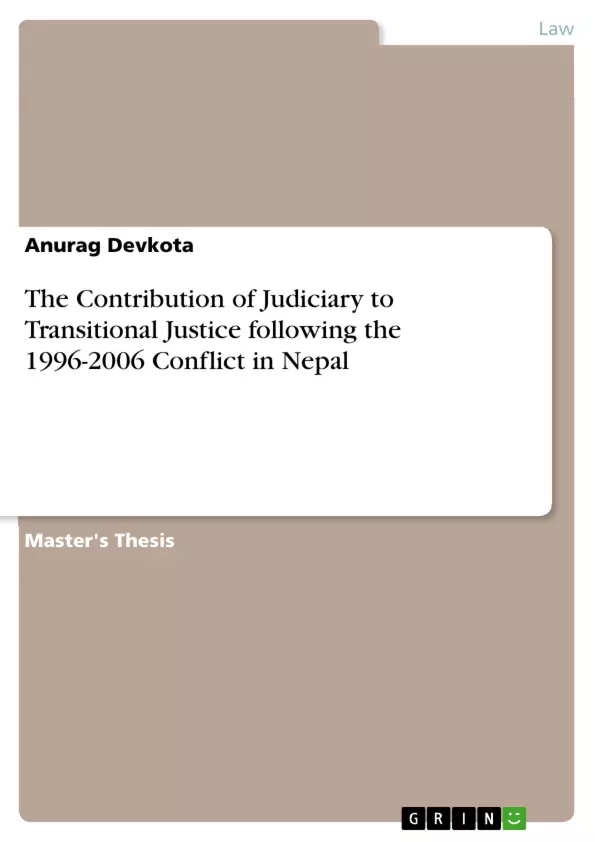As Nepal continues to debate how to deal with the legacy of the internal armed conflict of 1996-2006, the rule of law and transitional justice are of utmost importance in the current setting. This paper aims to find a possible solution to why it is critical that the judiciary is better engaged in Transitional Justice going forward. To that end, the paper explores the non-judicial mechanism as a failed idea in the context of Nepal, the significant impact and importance of the judiciary’s involvement in Transitional Justice, the complementary roles judiciary could provide to the non-judicial mechanisms, and the possible pitfalls of the judiciary in Nepal. The paper analyzes the constructive role played by the judiciary of Nepal to date and the prospect of dealing with the crimes of the past in the future, as well as establishing prosecution as the best possible option for Nepal in the period of transition. The research methodology used is doctrinal, using the study of reports and scholarly articles as a major source of data collection. Various reports published by different Non-Governmental and Governmental organizations have been used for research purposes as well.
Seeing as how the rule of law has been dismantled in this period of conflict, it can be established that judiciary has a better chance of re-establishing the rule of law in Nepal with a primary focus on access to justice through the prosecution. Uncovering the details of the past provides both a primer on what conditions permitted the violations of the rule of law in the past, and a deterrent to would-be human rights abusers of the future. Therefore, examining the crimes of the past via judiciary in the transitional justice scenario could help develop the institutional basis and the cultural norms to support the rule of law in Nepal. However, it is important to be cautious of the possible pitfalls of the judiciary in terms of dealing with the prosecution and its implementation.
Inhaltsverzeichnis (Table of Contents)
- Chapter One: Introduction and Background
- Introduction
- Statement of Purpose
- Literature Review
- Thesis Statement
- Limitations of the Study
- Significance/Implication
- Chapter Two: Overview of the Research Approach
- Research Methodology
- Research Questions
- Key Terms and Definitions
- Chapter Three: General Overview on People's War of Nepal 1996-2006
- Over view of people's war in Nepal
- The Maoist Insurgency (1996-2006)
- Cease Fire and Comprehensive Peace Accord
- Chapter Four: The Human Rights Situation during the People's War
- Major Human Rights violations during people's war
- Chapter Five: The Transitional Justice Mechanism in Nepal and the Contribution of Judiciary
- Post War and Transitional Justice Mechanisms: An Overview
- The Mechanisms of Transitional Justice
- Truth Commissions and Transitional Justice Prospects in Nepal
- The Pitfalls of Non Judicial Mechanism in Nepal
- Importance of Judicial Proceedings and International Obligation to be borne by the government of Nepal
- Contribution of judiciary on upholding international obligation and ensuring victims' access to justice in Nepal
- The complementary role of judiciary vis-à-vis non judicial mechanisms in Nepal
- The Possible Pitfalls of Judiciary in Dealing With The Past Crimes and Way Forward
Zielsetzung und Themenschwerpunkte (Objectives and Key Themes)
This paper aims to analyze the role of the judiciary in transitional justice in Nepal following the 1996-2006 conflict. It seeks to understand why judicial engagement is critical for successful transitional justice and explores the potential benefits and pitfalls of such engagement. The paper also examines the limitations of non-judicial mechanisms in Nepal and the importance of judicial proceedings in upholding international obligations and ensuring victims' access to justice.
- The role of the judiciary in transitional justice in Nepal
- The limitations of non-judicial mechanisms in Nepal
- The importance of judicial proceedings in upholding international obligations
- The potential benefits and pitfalls of judicial engagement in transitional justice
- The need for a balanced approach to transitional justice in Nepal
Zusammenfassung der Kapitel (Chapter Summaries)
Chapter One provides an introduction to the topic of transitional justice in Nepal, outlining the paper's purpose, scope, and methodology. It explores the concept of transitional justice, its relevance to the Nepalese context, and the challenges facing the country in dealing with the legacy of the conflict.
Chapter Two delves into the research approach, including the methodology, research questions, and key terms and definitions. It provides a framework for analyzing the role of the judiciary in transitional justice in Nepal.
Chapter Three offers an overview of the People's War of Nepal (1996-2006), including a discussion of the Maoist insurgency and the subsequent peace process. It examines the key events and factors that shaped the conflict and its impact on the country.
Chapter Four focuses on the human rights situation during the People's War, highlighting the major violations that occurred during this period. It provides context for understanding the need for transitional justice in Nepal.
Chapter Five delves into the transitional justice mechanisms in Nepal, examining the role of the judiciary in this process. It analyzes the strengths and limitations of different mechanisms, explores the potential pitfalls of judicial engagement, and highlights the importance of ensuring victims' access to justice.
Schlüsselwörter (Keywords)
This paper focuses on key terms and concepts related to transitional justice in Nepal, including the role of the judiciary, human rights violations, non-judicial mechanisms, truth commissions, international obligations, and victim's access to justice. It also examines the challenges and opportunities associated with dealing with the legacy of the 1996-2006 conflict in Nepal.
- Quote paper
- Anurag Devkota (Author), 2014, The Contribution of Judiciary to Transitional Justice following the 1996-2006 Conflict in Nepal, Munich, GRIN Verlag, https://www.grin.com/document/492436



